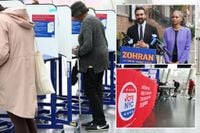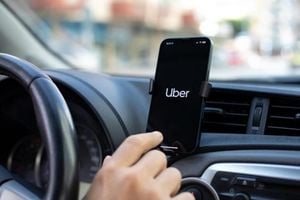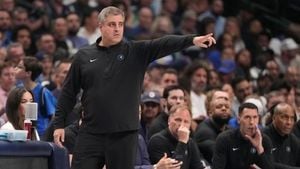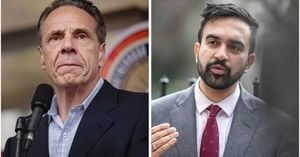New Yorkers are bracing for a historic and sweltering primary election day on Tuesday, June 24, 2025, as polls across the city open at 6 a.m. and close at 9 p.m. With temperatures expected to soar to a blistering 102 degrees, voters will face not only the heat but also one of the most hotly contested Democratic mayoral primaries in recent memory.
The stakes are high in the race for New York City’s top job, with nearly a dozen candidates vying for the Democratic nomination. Among them, former Governor Andrew Cuomo and state Assembly Member Zohran Mamdani have emerged as the frontrunners, locked in a tight battle that recent polls suggest could go either way. Cuomo, who resigned in 2021 amid sexual harassment allegations and controversies over his handling of the pandemic, is attempting a political comeback. Meanwhile, Mamdani, a 33-year-old progressive endorsed by Rep. Alexandria Ocasio-Cortez, has steadily closed the gap, even leading in some recent ranked-choice voting simulations.
New York City’s ranked-choice voting system, approved in 2019 and first used in 2021, adds an extra layer of complexity to the primary. Voters can rank up to five candidates in order of preference. If no candidate secures more than 50% of first-choice votes—which is widely expected—the election will move to subsequent rounds where the candidate with the fewest votes is eliminated, and their votes redistributed based on voters’ next choices. This process continues until a candidate achieves a majority, with the final result anticipated on July 1, a full week after Election Day.
Cuomo’s campaign has been marked by both resilience and controversy. After stepping down as governor following multiple allegations of inappropriate behavior, he has denied wrongdoing while emphasizing his experience and capability to lead the city. His recent speech at Union Square, surrounded by labor leaders and hundreds of union members, underscored his appeal to working-class New Yorkers and his ambition to reshape the Democratic Party after its 2024 setbacks.
On the other hand, Mamdani has positioned himself as a fresh progressive alternative, gaining momentum through strategic cross-endorsements with candidates like City Comptroller Brad Lander and Rev. Michael Blake. His rising popularity is reflected in polls such as the Emerson College Polling/Pix 11/The Hill survey released just a day before the primary, which showed Mamdani narrowly beating Cuomo 51.8% to 48.2% in the eighth round of ranked-choice voting. This tightening race has energized voters and added an unpredictable edge to the election.
Beyond the mayoral contest, New Yorkers will vote for other significant citywide offices, including city comptroller, public advocate, borough presidents, district attorneys, and City Council members. The only citywide Republican primary is for city comptroller, as Curtis Sliwa stands as the presumptive Republican candidate for mayor in the general election. Meanwhile, Mayor Eric Adams, who won the 2021 mayoralty through the Democratic primary but has since faced scandals and plummeting approval ratings, is running for re-election as an independent and is not on the primary ballot.
Voter turnout is expected to be robust, with early voting having already more than doubled the 2021 mayoral primary turnout. Approximately 400,000 New Yorkers cast ballots during the early voting period from June 14 to June 22, 2025. Given this surge, election officials anticipate long lines on primary day, especially during morning and evening rush hours. Recognizing the extreme heat, the city has urged voters to stay hydrated and avoid prolonged exposure. Notably, Governor Kathy Hochul recently signed legislation repealing a controversial section of election law that banned handing out water or refreshments to voters waiting in line, a move prompted by a successful lawsuit from the Brooklyn NAACP chapter.
For voters, finding the correct polling site is crucial, as locations may have changed since the last election. The New York City Board of Elections website provides a tool to locate polling places by entering one’s address. Importantly, voters who are in line by 9 p.m. are legally entitled to cast their ballots, even if the polls close while they wait. Additionally, absentee ballots postmarked by Election Day will be accepted if received by July 1, and can be dropped off at any poll site or Board of Elections office until 9 p.m. on Tuesday.
The Board of Elections will release unofficial first-choice vote totals on election night, but these will only provide a partial picture. Because of the ranked-choice system, final results won’t be known until the full tabulation is complete a week later. Election workers will collect about 3,600 hard drives from voting machines citywide to process the ranked rounds. Official certification of results is expected by mid-July.
Meanwhile, political maneuvering continues behind the scenes. Cuomo has filed petitions to appear on the general election ballot under an independent line should he fail to win the Democratic primary. The progressive Working Families Party is expected to back Mamdani’s campaign in the general election, setting the stage for a potentially fractious November race involving Cuomo, Mamdani, Republican Curtis Sliwa, independent Jim Walden, and incumbent Mayor Adams.
As the city braces for a scorching Election Day, the drama of New York’s mayoral primary underscores the complexities of modern urban politics. With ranked-choice voting reshaping electoral strategies, a crowded field, and a deeply divided electorate, the next mayor will emerge only after a week of intense vote counting and political calculation. For now, the city’s voters must navigate the heat and the lines, armed with their ranked ballots and the hope of shaping New York’s future.





